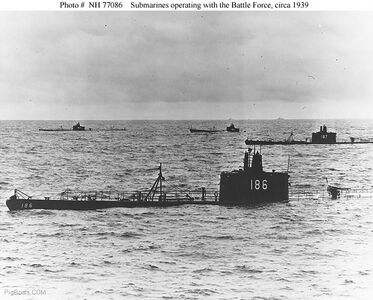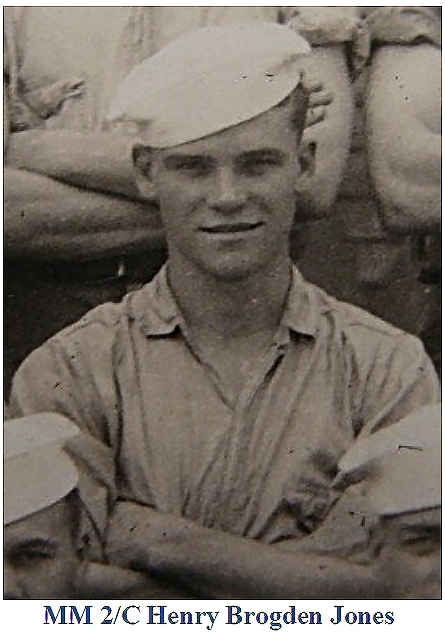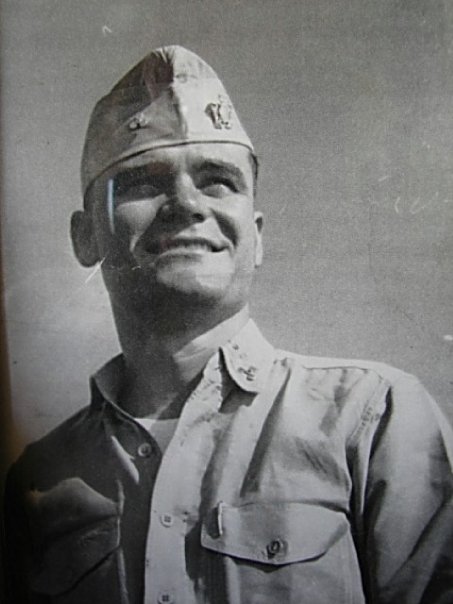186: Difference between revisions
Pbcjohnston (talk | contribs) mNo edit summary |
Pbcjohnston (talk | contribs) Added captions |
||
| Line 2: | Line 2: | ||
[[File:Stingray launch.jpg|left|500px]] | [[File:Stingray launch.jpg|left|500px]] | ||
<div style="text-align: justify;"><span style="color:#00008B">Stingray hitting the water for the first time at the Portsmouth Navy Yard, Kittery, Maine, October 6, 1937. Heavy drag chains have been attached to her hull, and these chains pay out as she slides into the water. They will arrest her motion before she gets to far into the Piscataqua River. Note that she is still carrying her "S5" class identifier. It would be replaced with her hull number in 1939. | |||
<small>U.S. Navy photo.</small> | |||
[[File:Red bar sub new.jpg]] | |||
[[File:Stingray stbd side running slow.jpg|left|500px]] | [[File:Stingray stbd side running slow.jpg|left|500px]] | ||
[[File:Stingray diving.jpg | Stingray moving sedately across a calm sea, approximately 1940. She made a cruise to the Caribbean that year, so this may be at a port call at one of the islands there. Her hull number has replaced the "S" identifier on her bow and fairwater. | ||
[[File: | <small>U.S. Navy photo.</small> | ||
[[File:Red bar sub new.jpg]] | |||
<center> | |||
<gallery mode="packed" widths="300px" heights="200px"> | |||
File:Stingray diving.jpg | |||
File:Stingray surfacing.jpg | |||
File:Stingray awash.jpg | |||
</gallery> | |||
</center> | |||
<div style="text-align: justify;"><span style="color:#00008B">A three photo sequence of Stingray first diving, then surfacing, while operating with three of her sisters during war games in 1939-1940. The boat in the immediate background is the [[187|'''Sturgeon (SS-187)''']]. The other two boats are also Salmon-class submarines, but their ID's are unknown. They are of the Electric Boat design, shown by the different shape of the conning tower fairwater. This is a posed photo. A pack of four submarines would ''never'' operate this closely together in wartime. This was formation steaming tactics forced onto the Submarine Force by surface admirals. | |||
<small>U.S. Navy photos.</small> | |||
[[File:Red bar sub new.jpg]] | |||
[[File:Stingray 1940.jpg|left|500px]] | [[File:Stingray 1940.jpg|left|500px]] | ||
Stingray seen with an unidentified shoreline in the background. The photo was originally identified as being off Pearl Harbor but there are too many residential neighborhoods for Hawaii of that time. We're inclined to think this is San Francisco or San Diego, circa 1940. | |||
<small>U.S. Navy photo.</small> | |||
[[File:Red bar sub new.jpg]] | |||
[[File:Stingray shellback cert.jpg|left|500px]] | [[File:Stingray shellback cert.jpg|left|500px]] | ||
[[File:Stingray jones.jpg | Ancient Order of the Deep Certificate issued to MM 2c Henry Brogden Jones. This is also known as a Shellback Certificate for crossing the equator, which they did on January 26, 1942 at 118° 51' east longitude. Jones had been a crewman on the [[195|'''Sealion (SS-195)''']] when it was bombed at Cavite on December 10, 1941. He was transferred to the Stingray after the destruction of his vessel. | ||
<small>Image courtesy of Bryan K. Jones, son of Henry Brogden Jones.</small> | |||
[[File:Red bar sub new.jpg]] | |||
<center> | |||
<gallery mode="packed" widths="500px" heights="600px"> | |||
File:Stingray jones.jpg | |||
File:Stingray jones 2.jpg | |||
</gallery> | |||
</center> | |||
<div style="text-align: justify;"><span style="color:#00008B">Two views of Jones, the one on the left as a Petty Officer 2nd Class in 1941, and on the right as a Chief Petty Officer in 1945. Rapid advancements were the norm during the war. | |||
<small>Images courtesy of Bryan K. Jones, son of Henry Brogden Jones.</small> | |||
[[File:Red bar sub new.jpg]] | |||
[[File:Stingray 1942.jpg|left|500px]] | [[File:Stingray 1942.jpg|left|500px]] | ||
Stingray after her 1st wartime overhaul at Mare Island, October 2, 1942. This is an early wartime mod, removing only the aft bulwark around the cigarette deck and adding radars. On the new fairwater gun deck the boat has received a Mk 5 mount for a 20 mm anti-aircraft gun. | |||
<small>Photo 19-N-36095 courtesy of NHHC.</small> | |||
[[File:Red bar sub new.jpg]] | |||
[[File:Stingray 1942 2.jpg|left|500px]] | [[File:Stingray 1942 2.jpg|left|500px]] | ||
Another photo taken at the same time as the one above, from a different angle. Stingray, like the rest of her Salmon/Sargo-class sisters, had four 21-inch torpedo tubes forward. Wanting more firepower but unable to significantly alter the structure of the forward torpedo room, the Navy chose to add two external tubes inside the superstructure forward. These tubes were single shot tubes, and they could be reloaded only in port. The weapons in the tubes could not be accessed for maintenance once loaded, and accuracy suffered as a result. The tube can be see just below the deck and above the anchor. Only five submarines received the exterior tubes, and the tubes were never well-liked. They were removed in later overhauls. | |||
<small>Photo 19-N-36097 courtesy of NHHC.</small> | |||
[[File:Red bar sub new.jpg]] | |||
[[File:Stingray 1942 3.jpg|left|500px]] | [[File:Stingray 1942 3.jpg|left|500px]] | ||
An interesting bow shot of Stingray on October 2, 1942 at the conclusion of her Mare Island overhaul. The external torpedo tubes are very apparent here. At this time Stingray retained her original cover pilothouse on the forward end of the conning tower fairwater, its circular windows can be seen here. Note also that these boats had the SJ surface search radar installed on a mast to ''starboard'' of the periscope shears, not in front of it like the later boats. This was because at this time she still retained her control room periscope, the shorter shear for it prevented the SJ from being mounted in the forward spot. The two arms sticking out from the side of the fairwater support radio aerial wires. | |||
<small>Photo 19-N-36098 courtesy of NHHC.</small> | |||
[[File:Red bar sub new.jpg]] | |||
[[File:Stingray 1944 amidships.jpg|left|500px]] | [[File:Stingray 1944 amidships.jpg|left|500px]] | ||
[[File:Stingray 1944 at pier.jpg|left|500px]] | [[File:Stingray 1944 at pier.jpg|left|500px]] | ||
Revision as of 21:16, 18 November 2023

U.S. Navy photo.

Stingray moving sedately across a calm sea, approximately 1940. She made a cruise to the Caribbean that year, so this may be at a port call at one of the islands there. Her hull number has replaced the "S" identifier on her bow and fairwater.
U.S. Navy photo.
U.S. Navy photos.
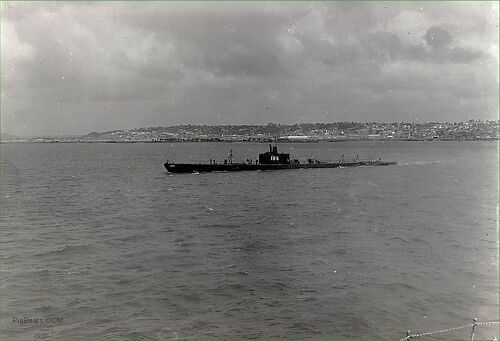
Stingray seen with an unidentified shoreline in the background. The photo was originally identified as being off Pearl Harbor but there are too many residential neighborhoods for Hawaii of that time. We're inclined to think this is San Francisco or San Diego, circa 1940.
U.S. Navy photo.

Ancient Order of the Deep Certificate issued to MM 2c Henry Brogden Jones. This is also known as a Shellback Certificate for crossing the equator, which they did on January 26, 1942 at 118° 51' east longitude. Jones had been a crewman on the Sealion (SS-195) when it was bombed at Cavite on December 10, 1941. He was transferred to the Stingray after the destruction of his vessel.
Image courtesy of Bryan K. Jones, son of Henry Brogden Jones.
Images courtesy of Bryan K. Jones, son of Henry Brogden Jones.

Stingray after her 1st wartime overhaul at Mare Island, October 2, 1942. This is an early wartime mod, removing only the aft bulwark around the cigarette deck and adding radars. On the new fairwater gun deck the boat has received a Mk 5 mount for a 20 mm anti-aircraft gun.
Photo 19-N-36095 courtesy of NHHC.
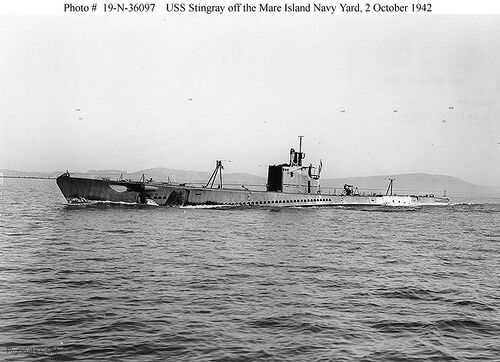
Another photo taken at the same time as the one above, from a different angle. Stingray, like the rest of her Salmon/Sargo-class sisters, had four 21-inch torpedo tubes forward. Wanting more firepower but unable to significantly alter the structure of the forward torpedo room, the Navy chose to add two external tubes inside the superstructure forward. These tubes were single shot tubes, and they could be reloaded only in port. The weapons in the tubes could not be accessed for maintenance once loaded, and accuracy suffered as a result. The tube can be see just below the deck and above the anchor. Only five submarines received the exterior tubes, and the tubes were never well-liked. They were removed in later overhauls.
Photo 19-N-36097 courtesy of NHHC.

An interesting bow shot of Stingray on October 2, 1942 at the conclusion of her Mare Island overhaul. The external torpedo tubes are very apparent here. At this time Stingray retained her original cover pilothouse on the forward end of the conning tower fairwater, its circular windows can be seen here. Note also that these boats had the SJ surface search radar installed on a mast to starboard of the periscope shears, not in front of it like the later boats. This was because at this time she still retained her control room periscope, the shorter shear for it prevented the SJ from being mounted in the forward spot. The two arms sticking out from the side of the fairwater support radio aerial wires.
Photo 19-N-36098 courtesy of NHHC.
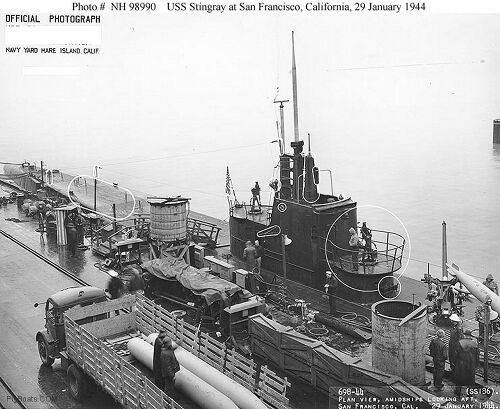
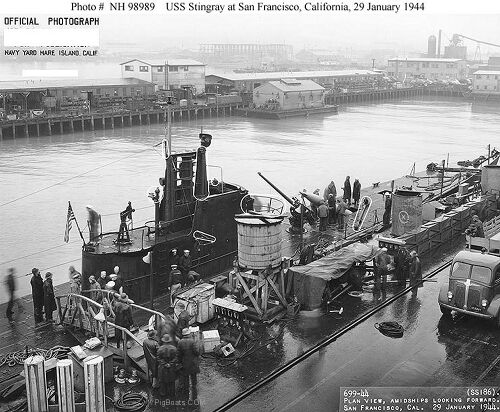
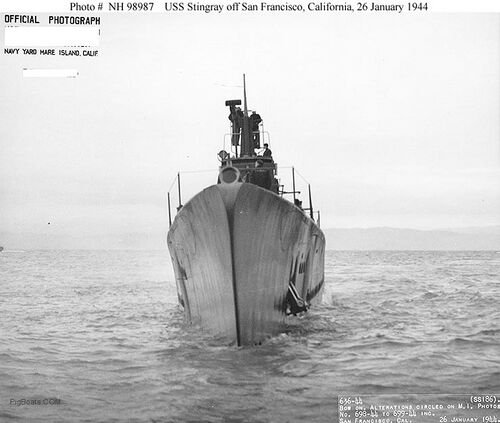
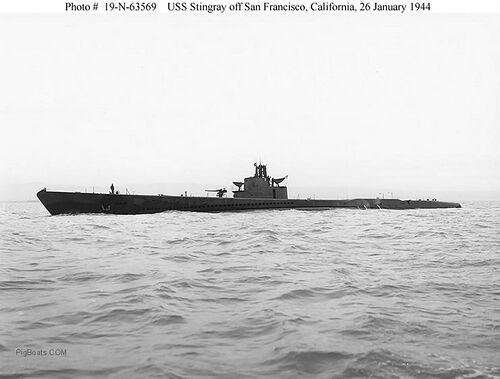
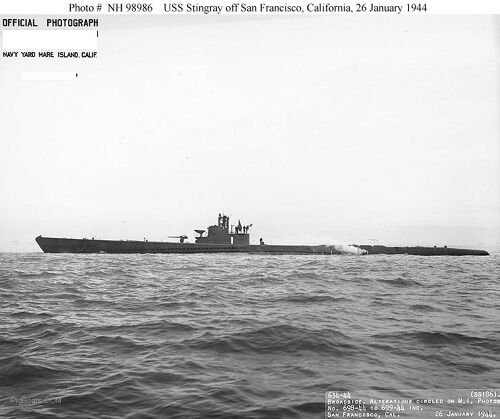
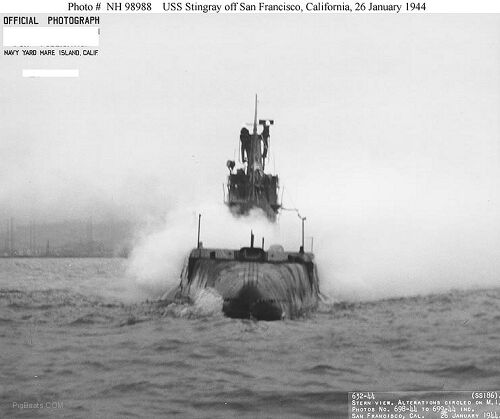
Photo in the private collection of Ric Hedman
Page created by:
Ric Hedman & David Johnston
1999 - 2023 - PigBoats.COM©
Mountlake Terrace, WA, Norfolk, VA
webmaster at pigboats dot com



